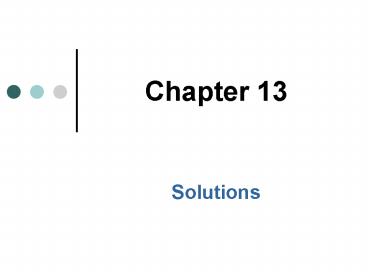Solutions PowerPoint PPT Presentation
1 / 10
Title: Solutions
1
Chapter 13
- Solutions
2
Homework, Chapter 13
- Problems, Pages 460 to 467
- 4, 15, 17, 27, 29, 61, 63, 65, 67, 69
- Blackboard Quiz
3
I. Introduction - Definitions
- Solution Homogeneous mixture of two or more
substances. - Solvent Single component of a solution which is
present in greatest amount. - Solutes Components of a solution which are
present in smaller amounts. - Concentration Measure of amount of solute in a
given volume of solution. - Solubility The amount of a compound that will
dissolve in a given volume of solvent.
4
II. Concentration Units
- 1. W/V g solute / mL solution x 100
- Example 18 g of NaCl is in 200. mL of solution.
What is NaCl? - 18 g / 200. mL x 100 9.0
- 2. Parts per Billion (ppb) ng solute / g
solution (mL if aqueous) - Example 520 ng of benzene are found in 1.0 L of
water. What is the ppb? - ppb 520 ng benzene / 1000 mL 0.52 ng/mL
5
II. Concentration Units
- 3. Molarity moles solute / L solution M
m/L - - This is the most popular concentration unit.
- - May have to calculate M, L or moles (m). Use
the equations - M m/L m MxL L m/M
6
II. Concentration Units
- a) What is the M if dissolve 4 moles in 0.5 L?
- M m/L 4 m / 0.5 L 8 m/L or 8 M
- b) 0.80 g of NaOH is dissolved in 200. mL (0.200
L). Calculate the M - 0.80 g NaOH x 1 mol NaOH / 40. g NaOH 0.020
mol NaOH - M m/L 0.020 mol / 0.200 L 0.10 m/L
or 0.10 M NaOH - c) How many moles of HI are in 3.0 L of 2.0 M HI?
- M m/L m M x L 2.0 m/L HI x
3.0 L 6.0 moles HI
7
II. Concentration Units
- D) 40. mL of 0.10 M (m/L) H2SO4 are required to
react with 30. mL of a solution containing NaOH.
How many moles of NaOH are present? - 1 H2SO4 2 NaOH ----------) 1
Na2SO4 2 H2O - First calculate moles of H2SO4 and then using the
balanced equation, calculate moles of NaOH. - 0.10 m/L H2SO4 x 0.040 L H2SO4 4.0 x 10-3 m
H2SO4 - 4.0 x 10-3 m H2SO4 x (2 m NaOH / 1 m H2SO4)
8.0 x 10-3 m NaOH
8
II. Concentration Units
- Lab Example 1MnO4- 8H 5Fe2 ---) 1Mn2
5Fe3 4H2O - How many mg of Fe2 are in a tablet that required
9.65 mL of 5.00x10-3 M KMnO4 for titration? - Moles MnO4- 5.00x10-3 m/L KMnO4 x 9.65
x10-3 L 4.83x10-5 moles - Moles of Fe2 4.83x10-5 m MnO4- x 5m Fe2/1m
MnO4- 2.41x10-4 moles - mg Fe2 (2.41x10-4 moles Fe2) x (55.9x103 mg
Fe2/1m Fe2) 13.5 mg Fe2
9
Fe Titration Lab
10
III. Solubility
- Soluble and Insoluble refer to how much solute
dissolves in a given solvent with water being the
most common solvent. - Group IA, nitrate, acetate and ammonium compounds
are very soluble in water as an example. - Water dissolves a large variety of ionic and less
polar compds. - Non-polar compounds like organic compounds do not
dissolve in water, but dissolve in organic
solvents like hexane or benzene - The general rule on solubility is Like Dissolves
Like. - Questions Why does water generally wash off pop
stains? - Why does water not take off grease stains?
- Why does soapy water take off both?

